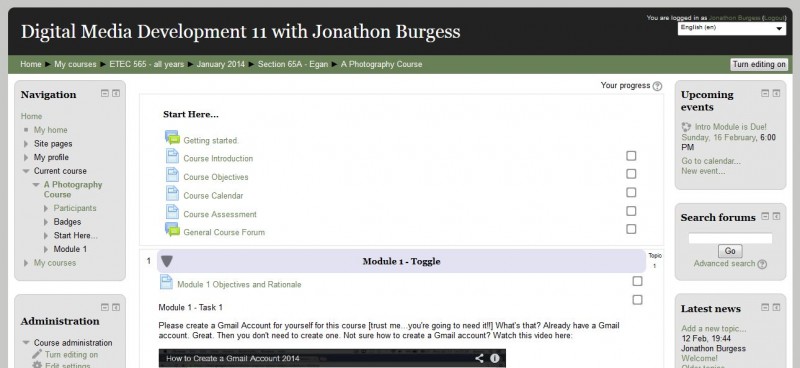Building within Moodle has been an experience somewhat like Alice falling down the rabbit hole. Whoosh! Experiential learning at its core. And experimenting with Moodle is one of the main objectives I had when signing up for ETEC 565 – I wanted to play. The Moodle “playground” is an expansive universe where a course developer will need a considerable amount of time to build, reflect, and revise as time allows.
As I moved from adding activities to adding resources, and then managing content within these artifacts, I quickly realized that Moodle is a course unto itself. The layers and complexity of this platform is quite staggering. As frustrated as I felt at times, I was relieved that Moodle has a great support resource and forum dedicated to ‘newbies’ like me to their platform. The forum was complete with links to great “How To” guides and explanations designed by Moodle as well as links which directed me to online presentations and videos in YouTube.
When building my Moodle site, I tried to keep Anderson’s (2008) words close to heart:
“[E]ffective learning is community-centred, knowledge-centred, learner-centred, and assessment-centred.”
My site, an investigation into photography and photographic techniques, has students:
- share their knowledge of photography topics
- express their ‘wishlist’ of what they would like to learn
- investigate online resources related to photography
- create online spaces within which to share photographs with both the instructor and one another.
Online spaces to share work in my Module centre on Flikr, a photograph-centred, social media juggernaut. Mabrito and Medley (2008) support the use of Flikr as an alternative tool of knowledge expression,
…a collection of images on Flickr with authorial comments and tags certainly does not resemble the traditional essay, but the time spent on such a project, the motivation for undertaking it, and its ability to communicate meaning can certainly be equal to the investment and motivation required by the traditional essay—and the photos may actually provide more meaningful communication for their intended audience.
Assessment of work in my Module is both student-student and teacher-student. I believe assessment and feedback are the key motivators for learning in many students. “In a comprehensive review of 87 meta-analyses of studies of what makes a difference to student achievement, Hattie (1987) reports that the most powerful single influence is feedback.” (Gibbs and Simpson, 2004). Learners in my Module are directed to give formative feedback in support of their peers and then reflect on feedback from their peers so they can refine work and push their photographic creativity.
…Brookhart (2001) found that successful students use both marks and feedback and actively self-assess, both to learn and to direct their future studying. The most important variables here may be, as so often, to do with the student rather than with the teacher. (Gibbs and Simpson, 2004).
While creativity is encouraged, I designed my Module to be released in a somewhat sequential order. For example, Module 2 is “time released” only upon completion of key aspects of the Introductory Module [ie. “Module 1 – Task 2 (An Album)” and “Module 1 – Task 3 (Getting to Know You)”]. Within Module 2, specific tasks must be marked completed before access is granted to further activities in order to ensure that students are not tempted to skip steps in learning and miss opportunities to give and receive feedback for their efforts.
Upon completing my Moodle site experience, questions remain as to how this platform might improve learning at my school. The adult learning centre where I work caters mainly to students who did not finish High School. In particular, organizational and problem solving skills are generally lacking in much of our student population. I believe that working in an online environment is not for everyone as it takes heaps of personal drive as well as a threshold of technical skill. Students who feel anxious of exploration with digital tools may find themselves quickly “lost” in the Web 2.0 sphere.
One affordance of Moodle which may assist our student body is the ability to share ideas in an asynchronous nature. A large percentage of our students can not make F2F courses because of other commitments (eg. work and children) or physical barriers such as lack of transportation.
In the end, I am glad that I had this experience to work within Moodle and peek under the hood at what this learning platform has to offer. I will bring my experiences to my colleagues and begin a conversation of whether our centre would benefit from instigating an online LMS.
Anderson, T. (2008). Towards a theory of online learning. Theory and practice of online learning. 45-74.
Gibbs, G., & Simpson, C. (2004). Conditions under which assessment supports students’ learning. Learning and teaching in higher education, 1(1), 3-31.
Mabrito, M., & Medley, R. (2008). Why Professor Johnny can’t read: Understanding the Net Generation’s texts. Innovate: Journal of Online Education, 4(6).


